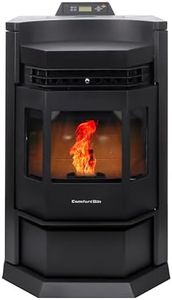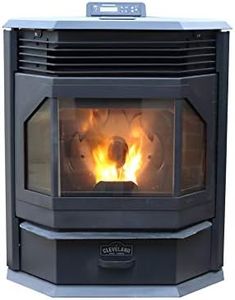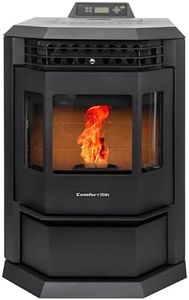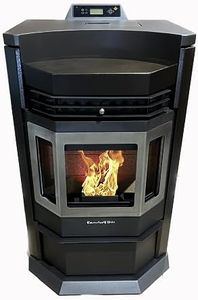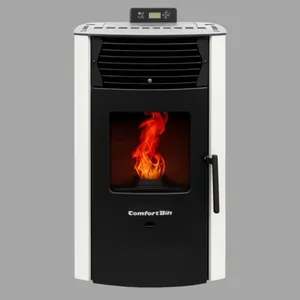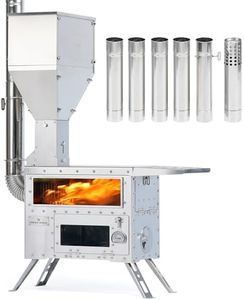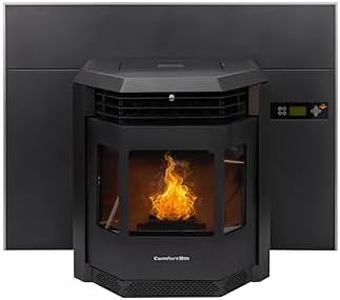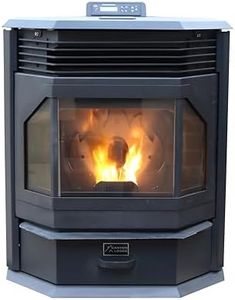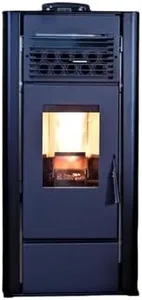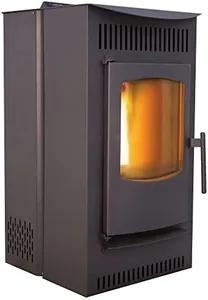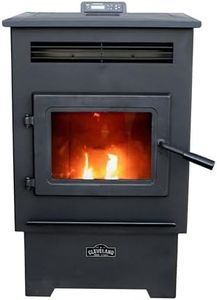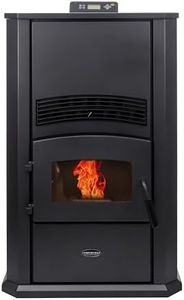10 Best Pellet Stoves 2025 in the United States
Our technology thoroughly searches through the online shopping world, reviewing hundreds of sites. We then process and analyze this information, updating in real-time to bring you the latest top-rated products. This way, you always get the best and most current options available.

Our Top Picks
Winner
Comfortbilt HP22-N Pellet Stove Black EPA Approved Smart Controller 80 Lb. Hopper
Most important from
84 reviews
The Comfortbilt HP22-N Pellet Stove is a solid choice for those looking to heat larger spaces, capable of covering up to 2,800 square feet with its 50,000 BTU output. This model boasts a generous 80-pound hopper, allowing for extended burn times without the need for frequent refills, making it convenient for users. Its auto ignition and programmable thermostat add to its user-friendly design, enabling efficient temperature management. This stove is EPA-approved and qualifies for a 30% IRS Stove Tax Credit, providing an added financial incentive for buyers.
There are some considerations to keep in mind. The need for proper ventilation means that installation may require additional planning and expenses, particularly if your space isn't already set up for it. While the heating capacity is impressive, efficiency ratings are important to understand your expected fuel consumption and emissions.
This pellet stove is best suited for homeowners looking for an efficient heating solution for larger areas and who are willing to handle the installation challenges. It strikes a good balance between performance and convenience but may not be ideal for those seeking a more portable or low-maintenance heating option.
Most important from
84 reviews
Canyon Lodge Large Pellet Stove heats up to 3000 sq ft with a 130 lb hopper
Most important from
12 reviews
The Canyon Lodge Large Pellet Stove is designed to heat medium to large spaces, covering between 2,000 to 3,000 square feet, making it suitable for bigger homes or open areas. Its 130-pound hopper is quite large, meaning you can load more fuel at once and enjoy longer burn times without frequent refilling. This is handy if you want a stove that runs steadily with less hassle. The stove is EPA certified and qualifies for a 30% IRS Biomass Stove Tax Credit, signaling that it meets good standards for efficiency and emissions, which means cleaner burning and less environmental impact.
It features a digital control panel and remote, plus built-in WiFi for smart home integration, adding convenience if you like managing your stove remotely or setting schedules. The Whisper Quiet Blower Technology helps distribute heat efficiently without loud noise, which is a plus for comfort. The fresh air supply kit helps with proper ventilation, important for safety and stove performance. Assembly is required, which might be a bit of a challenge if you're not handy, and the stove is relatively heavy at 211 pounds. Its ventilation is vent-free, so make sure your space is suitable for that setup.
If you want a large-capacity pellet stove with modern controls and good heating power, the Canyon Lodge offers strong features, though it requires space and some setup effort.
Most important from
12 reviews
PelPro PP150 Pellet Stove for Home Heating - 150 lb Hopper, 49,200 BTU Heats up to 2,500 Sq. Ft., Easy-Dial Temp Control, Built-in Thermostat with Auto-Ignition, Powerful & Quiet 265CFM Blower
Most important from
4 reviews
The PelPro PP150 pellet stove is a strong option for heating spaces up to 2,500 square feet, making it suitable for various homes including older houses, cabins, garages, and even mobile homes. It provides nearly 50,000 BTUs of heat, which is a solid output for its size. One of its standout features is the large 150-pound hopper capacity—the biggest in its class—which means you can go up to about four days without refilling the fuel, and it can be expanded if needed.
It is EPA-certified with an efficiency rating of 87.5%, so it uses fuel effectively and keeps heating costs down. The stove also boasts low emissions, contributing to cleaner indoor air quality. The built-in thermostat with easy dial controls and 10 heat settings lets you adjust the temperature comfortably, and the quiet 265 CFM blower helps spread warmth evenly without noise disruption. The auto-ignition system is convenient and energy-efficient, requiring no batteries.
The stove is relatively heavy at 233 pounds and might require professional installation, especially since ventilation and a fresh air kit are important for safe operation. Pellet stoves generally need regular cleaning to operate efficiently, and this model follows that norm. For those seeking a reliable, efficient pellet stove with a large fuel capacity and user-friendly controls, the PP150 is a suitable choice for medium to larger rooms or homes.
Most important from
4 reviews
Buying Guide for the Best Pellet Stoves
Pellet stoves are a great option for heating your home efficiently and sustainably. They burn compressed wood or biomass pellets to generate heat, and they can be a cost-effective and environmentally friendly alternative to traditional heating methods. When choosing a pellet stove, it's important to consider several key specifications to ensure you select the right model for your needs. Understanding these specs will help you make an informed decision and find a stove that fits your heating requirements, space, and lifestyle.FAQ
Most Popular Categories Right Now
